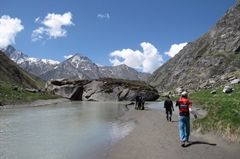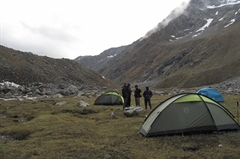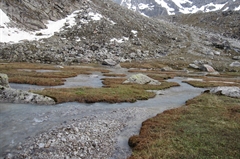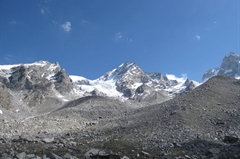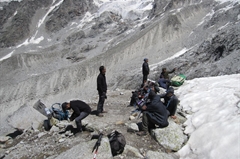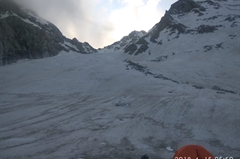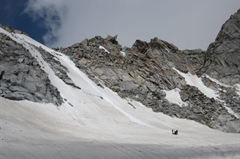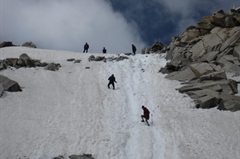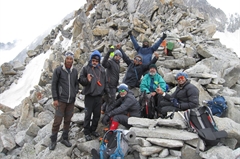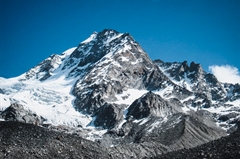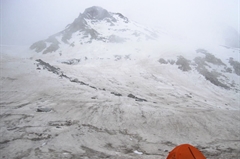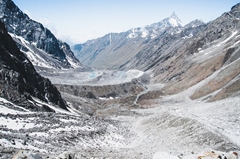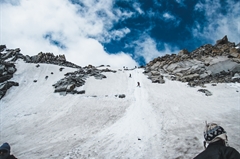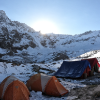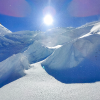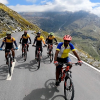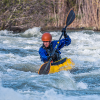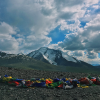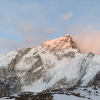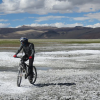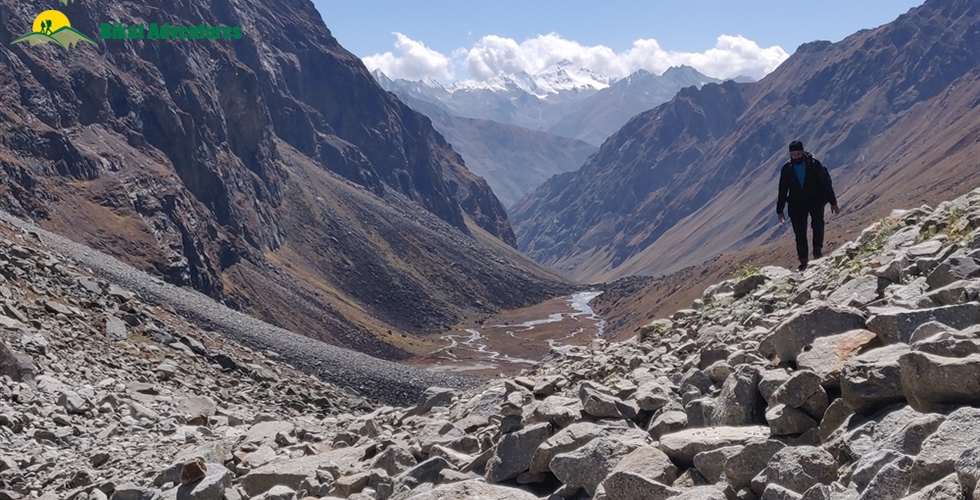
Borasu Pass Trek
A Thrilling Cross-Over Trek connecting Har Ki Dun to Baspa Valley
Available Batches
Available Batches
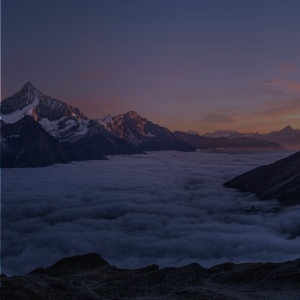
Brief Description
Brief Itinerary
Detailed Itinerary
Day 1
Make your way to Sankri (1,920M)
Distance: 185 kms drive
Duration: 8-9 hours
If you have signed up with Bikat for a drive from Dehradun to Sankri, our day starts early. All of us assemble at the meeting point by 7 in the morning so we can start our long drive up to Sankri – a trekking hub in the Garhwal region of Uttarakhand. Although there’s nothing more on the agenda for today other than the 9-hour drive and settling into mountain air, it is better to leave as early as possible for two reasons:
One, so we can reach as early as possible and give our bodies enough rest for what’s coming the next day. And, two, roads on the mountains are unpredictable and it is always better to account for delays when we start. It is also better to reach before it gets dark.
Sankri is a head trail for a lot of trekking routes and is bustling with trekkers across the year. Popular trails such as Har ki Dun, Baraadsar Lake, Bali Pass, Kedarkantha, Dev Kyara, Phulara ridge to name a few, all start from this scenic village centered in the background of some of the most splendid mountains in the region.
The drive from Dehradun takes us on scenic mountain roads. If you have the slightest motion sickness, the smooth roads can easily make your head spin with its curves. The ever-changing landscape with each turn, however, is a good way to keep yourself distracted. Tall trees, massive fields and entire mountain faces cut into steps for farming are views you wouldn’t want to miss for some shuteye. The drive takes you through some very big towns but also alternates between small patches of busy roads with village shops and long empty stretches with nothing but the sound of the wind and the birds.
The constant shift between the noise and the calm has a different sense of serenity attached to it. What’s even better is that breakfast and lunch, in local dhabas along the way make sure we get to indulge our tastebuds in some locally popular cuisine. The last two hours of the drive take us through a smooth road lined with thick forests on both sides. The sparkle of the forest is enough to refresh us from the long drive to get to our destination. Sankri is a head trail for a lot of popular treks and hence is not short on facilities. Although there is no phone network in Sankri, you can probably find a shop in the market which will be happy to loan you wi-fi in case of an urgent need.
Waiting for us, at the end of the trail of this back-breaking journey will be a warm, wooden homestay with cozy rooms and a home cooked meal. Expect to reach latest by 7 PM.
If you have not opted for travel with Bikat from Dehradun to Sankri and are to meet the group directly at the head trail, check out the article on how to reach Sankri (click here) for any assistance. Do plan your travel so as to reach Sankri latest by 7 in the evening. (Please note: Bikat can arrange for your transport for an additional cost as mentioned in the Add-Ons section above.)
Day 2
Sankri (1,920M) to Seema (2,260M) through Dhatmeer (2,400M)
Distance: 18 kms + 6-7 kms
Duration: 1.5 hours drive + 5-6 hours
Today is an early day because there is much ground to cover. We should be done with breakfast anytime between 7-8 AM which gives us enough time to soak in the morning sun and the beauty of this mountain town before we leave for the day by 9 AM.
There is a narrow kaccha road that can be covered on wheels. Do not, however, expect this to be a quick drive – we are likely to encounter JCBs shoving parts of fallen mountain off the narrow roads on multiple patches all through the 18 km stretch. The drive should take anywhere between 1-2 hours based on how many times we have to wait for the road to clear. The waiting does not seem too tiresome for the fresh water streams with fantastical views of the forest and mountains. A deep gorge with a stream(nalla) flowing underneath is invigorating. The nip in the air keeps your senses active and the mind, refreshed.
At the end of the road is a small mountain village named Gangad, bursting with colours. You will know you have reached when you see rows of mules standing obediently in a line, facing the mountain and about a dozen tiny canteens lined up to serve you hot food in case you shall need it before your trek! A lot of popular treks like Har ki Dun and Bali Pass start from here, so it is forever bustling with the contagious energy of trekkers.
After breakfast and picking up our packed lunches for the day, we set off towards Seema which is going to be our first campsite on this trek. Although we are not gaining much altitude today (just 160M from Dhatmeer to Seema), the length of the walk is the real challenge. The trek starts on even land with a strong smell of the forest in the air; the lush landscape adorned with waterfalls by a half dozen. The land is mostly even, save the jumping over massive fallen trees and big boulders. The inclines otherwise are gradual with the grayish blue of the boisterous Supin river following alongside as a faithful companion.
After an hour of climb we reach our first clearing out of the forest. You will see two dome-like structures built as a stop-and-rest space to keep you from the harsh sun. Another hour into the trek and the trail opens up on one side to expansive views of the valley. This is when we hit our first patch of steep incline which will take all of 10 mins to cover but is efficient enough to make you stop for a breath or two. The next hour seems like quite a relief, then, for it being a flat land with a few humps along the way. It’s a steady incline from here on. We hit one more food joint one hour away from the campsite – stack up on some energy if the trail’s knocked some air out of you.
The forest floor is wet and mucky and gets slippery. Remember to walk carefully. The shiny dots you see covering the mountain faces on the opposite side are houses of entire villages resting precariously on these rugged slopes. The only traffic jams you are likely to encounter on these routes are cows going about their business for the day as you try to squeeze through the crowds of them on these narrow trails.
Expect to reach the campsite latest by 6 in the evening after a 6 hour trek. The 2 km stretch of the long camping ground has rooms available with views of the mountains.Take your pick of the view you want to pitch your tent to and rest your weary self for the night.
Day 3
Seema (2,260M) to Har ki Dun (3,510M)
Distance: 16 kms
Duration: 7-8 hours
Since we are gaining a fair bit of altitude today (1,250M), we follow the same schedule as yesterday – an early start after an early breakfast. The trail continues on the terrain from day 2, on a wet, stone-paved surface with a slippery personality. As soon as we start the trek, we cross a small village. There are plenty of water streams on the way today. Forty-five minutes into the trek we reach a suspension bridge to cross over to the other mountain which is followed by a twenty-minute steep ascend to reach flat land again. At the end of the ascend, you would have made it out of the area rife with tall trees and into much wider valleys with smaller shrubs and expansive views. It is a gradual but continuous ascend from here on.
As the sun comes to its highest point for the day, we are treated to our first sight of the mythological giants Swargarohini and Bandarpoonch peaks and the infamous Black Peak. This is also when we hit a patch of flat ground so we can admire these marvels while also continuing to cover some ground. The respite, however, is short-lived. Steep ascends start again after 10 minutes and continue on for an hour and a half. Just when we thought we would have gained enough height for the day, our heart sinks to find out that the next patch is a steep descend where we will lose a lot of the height we had earned in the past few hours. The beauty of the trail starts to get thicker as we move on – two hours after noon you will find yourself walking amongst plants taller than yourself, fanciful with all their green, flowy leaves.
The landscape changes face quickly from here. Suddenly out from feeling closed in by the tall trees, we find ourselves amongst shrubs growing in all directions. The warm colours of the landscape, and flowers (red orange yellow - the whole spectrum) automatically make you feel warm stripping the cold air off some of its power. The trail is rich in variety of leaves and bushes - the valley a messy wardrobe of rich and colourful flowers scattered on the ground in no specific order. The route has you witness mountains of all kinds, from naked, vertical rockfaces using the sun as their personal reflectors, to greens on the foothills and the brown scree sliding down the gentle slopes like oily sweat.
If you have ever walked the Har ki Dun trail, you will know the insurmountable beauty and the pleasant performance this valley has to offer. Expect to reach the campsite latest by 4 in the afternoon. Make sure to open your tents towards Swargarohini so you can enjoy its beauty and might as you sit next to the cold water of the Supin river and sip on some fuming tea. Could there be anything better to chase the weariness of the day away? If you feel the quietude of the place is too much to take, the soft sound of the gushing water will be your best comrade through the night.
Day 4
Har ki Dun (3,510M) to Ratha Tho (4,110M) via Morinda Tal (3,800 M)
Distance: 5 kms
Duration: 3-4 hours
Today is when our excitement sees a new height since this is the beginning of that trail – the one that goes beyond! Today is when we take the road less travelled and go beyond Har ki Dun. It is a lax day, there is not much ground to cover and the terrain is fairly simple. We even have enough time to go exploring this beautiful valley of the Gods (Har ki Dun). Go up the mountain on the other side of the river to get a more unobstructed view of the mythological giant, Swargarohini and the exquisite world the heap of rocks was loyally guarding.
We start on our journey ‘beyond’ anywhere between 9 and 10 AM. The first thing we notice as we start for the day is that the crowds have already started thinning out since we are now heading out of the popular trekking route towards a more virgin land. The drama of the high mountains wearing clouds like crowns and the sunlight peeping out from behind them like a shy kid not wanting to come out but afraid of missing all the action only has us as its sole witness in this unmapped territory. It’s like you own the view like you do in a heated argument.
The first hour of the climb is a steady but gradual incline which is followed by 20 minutes of flat ground that will bring us straight to Morinda Tal. This is yet another exciting feature not many get to witness despite being so close to Har ki Dun. This lake which sits still, bang in the middle of the restless winds, swaying grass and rocks; stands out as much for its tranquility as for its turquoise colour. The wide, open field is home to abandoned stone structures used by shepherds as shelters. The valley in front now changes color, suddenly turning brown with short blades of dry grass – no shrubs either.
Ten minutes into this valley we hit a ten-minute patch of big boulders which on successful crossing leads us to a patch of flat land and then a steady incline. Walking through the Morinda valley is literally a walk in the park. And since it is a fairly easy day, we take some time to lie on our backs in the dry grass and look up to the sky. When you do that, you will see the clouds idly rolling past the high mountains before they slowly dissipate into thin air. To witness this phenomenon, on loop, is nothing short of magical.
The gradual 600M of height gain through wide meadows today couldn’t be more relaxing. From green to the land of golden, we have now entered the zone which can support very little life. The trail after the lake is gentle humps through golden meadows with a few wildflowers still holding strong in this cold land. After joyously taking your time on the trail, expect to reach camp just in time for hot lunch.
Day 5
Ratha Tho (4,110M) to Saunbhera (4,400M)
Distance: 6 kms
Duration: 3 hours
Today is again a short day with a 300M altitude gain across 6 kms. Given the altitude and the cold, we will wait for the sun to come out before we start the day. As the crowds on the way to these popular treks start to thin, so does the vegetation on the route, flipping the entire vibe of the trek on its head. There’s only scree, moraine and boulders till our eye can see - glaciers in the distance and absolutely no grass, even the dry grass has now retired. We have crossed very quickly from the tree line to dry grass to an absolute absence of vegetation.
The first half hour of the trek is through boulders post which a gradual ascend begins. If we’d thought Har ki Dun was pretty, it only gets better from here! We, for one, had not expected this unfettered lay of beauty that we were now witnessing. Tiny specks of pollen flying in the air like snowflakes, streams spread across the land like veins of the earth. Triangular rocks and mountain faces with sharp edges look like Picasso paintings from his Guernica period. Two hours after we started to ascend, we hit patches of descent. The valley takes sharp turns and changes direction a lot of time. The river here wears an even deeper colour. The sound of dry leaves crushing under your legs and the texture of the rock as you run your hands on its surface are some sensations you might want to experience. The feeling when the ground is mushy and holds you in your place like it’s telling you to go no further, is surreal. The last 10 minutes of the trek before we reach the campsite for today at the foot of the glacier is on a zero-degree gradient. It is a pleasant change after having to maneuver through boulders for the rest of the trail.
This campsite with a direct view of the route to the pass seems a stone’s throw away from here but is actually hours of climb. But that’s our worry for another day. For today, we spend the rest of our time acclimatizing to the thin air and exploring the vast, open ground to discover its various colours, textures and shapes. And to do it, without no one around is only an added advantage.
Day 6
Saunbhera (4,400M) to Borasu Pass Base Camp (Upper Lamjung) (4,730M)
Distance: 3 kms
Duration: 2 hours
Today is the shortest day on the trek. We leave late after the sun makes an appearance and reach before lunch. The trail is all boulders which is good practice for what’s to come the next two days. Crossing the flat land of the campsite takes only a few minutes before we reach the foot of the boulders and start our climb up. We follow a narrow ridge all the way up to the small space which will be our campsite for tonight. One and a half hour into the climb, we will reach the top of the first ridge. Take a few minutes to rest and get a bird’s eye view of the campsite of Saunbhera, where veins of streams divide the land into geometric shapes – the flat ground appearing as hexagonal grasslands below. It was one sight we couldn’t tear our gaze away from. After a few minutes of straight walk at the end of the first ridge, we begin incline on the second and the last ridge which should take about half an hour to cover.
The base camp for the pass is called Upper Lamjung. Lamjung, in local language, means ‘Long Moustache’ named as such for the shape of the lower ridges and how they appear from below. Expect to reach the Upper ‘long moustache’ within two hours. The campsite is compact and tricky to set up. It is uneven and full of rocks. Take it from us when we say this is not going to be one of your most comfortable nights in the mountains! The pass hides behind the many folds of the glacier in this area. The campsite here is pretty exciting for it is protected by rockfall by a dip in the terrain. While the dip can keep the rock away, there is no way to stop the continuous sound of the rumble of rocks falling hither thither.
The terrain around us is stunning. If you stand with your back to the campsite, to your right are gentle slopes of mountains of varying hues and to your left are intimidating structures with pointed ridges and falling rock. If you get a clear sky, you will also get a bird’s eye view of the many glacial lakes sitting idly in the distant landscape.
The ground on the base where we set camp looks like fallen rocks someone pushed off a pile. Cloud forms dissipating and melting into the next form, taking on different personalities - you could spend hours looking at the shapes and structures around you. The only sound that will consume you though is the rumble of rockfall somewhere in the area once every few minutes. There is a thick layer of ice on the upper half of the mountain, you can hear the sound of water but have to go hunting to actually find it.
The way up from this point has so many rocks, it looks like ruins from a well-built civilization from far back in history.
Day 7
Upper Lamjung (4,730M) to Bonga (4,500 M) via Borasu Pass (5,200 M)
Distance: 10-11 kms
Duration: 10 hours
Today is ‘the day’ and it is going to be a long one – 500M up to the pass and a descend of 700M from the pass on to the next campsite. We start as early as possible, even before the sunlight starts chasing peaks, slowly creeping up on one mountain top after another as they shed off their darkness little by little. An hour into the steep, heavily bouldered climb, we reach the base of the glacier. This is where we will gear up – put on our crampons/ microspikes. The slope of the glacier is not more than 30 degrees as it starts but very quickly turns into 70 degrees with alternating rock and snow patches a little further up. The last bit up to the pass is almost vertical and can feel a little intimidating.
The ascend is not the major challenge for the day. We reach the pass in less than 3 hours. The view from the top which lies at the daunting altitude of 5,200M is mesmerizing. Snow covered peaks with browns and whites playing chase with each other forming peculiar patterns on the high mountains all around. After a small prayer on the pass, we start the difficult part of the journey – the long and arduous descend. The first bit itself looks like a direct drop. It will require roping up or fixing ropes for a safe descent. The initial section, which is a 75 degree slope takes close to 40 minutes to descend. Post this, we hit a large patch of almost flat snow which slowly descends downwards. This section has a lot of open and hidden crevasses, however, and needs to be crossed with caution. It also has sections with steep slopes on one side which could take you straight down, in case of a single slip. By the end of 45 minutes on this terrain, we would have already descended 300M and reached the end of the snow section.
What comes next is especially daunting– hours of sharp ascend and descend on boulders as big as dreams. The need to exercise caution on every tiny step forward, to avoid the gaps between these boulders, is extremely tiring. The next section which brings us down by 200M looks like a small distance to cover but takes close to an hour and a half. It is a steep descend with no specific trail and requires navigating massive boulders. Given that this is a fresh trek not attempted by many, the route has no marked trail which was our favourite part since it gave us a free reign to explore.
Once at the base of this section, we will walk for 45 minutes on the rocky ground to make it to the mountains on the other side of the glacial bed. We need to catch the ridge of the mountain you see ahead. But in order to do that, we have to climb up a steep slope of scree and loose rocks. This section which will take not more than 50 steps to climb might make you think 50 times before you do it. Once on the ridge, the walk is pretty straightforward, although it is on a narrow trail with loose rocks, so you might want to be extra careful. Half an hour on the ridge and the landscape starts to fill a little with colour. The snow-capped peaks are now pushed into the backdrop. Streams can be seen and not just heard.
After walking the ridge and welcoming colour back into our field of vision for 45 minutes, we descend to take the lower ridge. Flowers get added to the mix of dry grass and life is starting to thrive in this terrain. Expect to reach the campsite for today by early evening. The campsite is in warmer lands with plentiful colours and a stream flowing by our tents. The temperature, however, is still low – do not be surprised if you wake up to a sheet of ice keeping you from getting to the water of the stream, like it did us!
Day 8
Bonga (4,500 M) to Chitkul (3,280 M)
Distance: 14 kms
Duration: 8 hours
Today is a long and hard day too, firstly because of the distance and secondly, for the difficult terrain. Since the previous day was wearisome, today might seem a bit harder. We leave after breakfast by around 9 AM. Carry sufficient water with you since the first water source is 2.5 hours away. The terrain for today includes a fair bit of steep ascends and descends, all on massive boulders across an exposed mountain face with a steep drop. There is no specific trail which makes things harder. This challenging terrain full of boulders reaches its end by 12:30 AM, as you start seeing some vegetation and finally find flat and firm land to walk on. An hour and a half more and the tree line starts to appear. We could hardly contain our glee when we heard the crispy yellow leaves of entire mountains full of Bhojpatra trees make music in the air. Walking through thick, golden forests of Bhojpatra is extremely refreshing after the cold terrain we spent hours on.
An hour more and we reach open grasslands with huge humps taking us up and down - but the warmth of seeing life around us on these small hills keeps this a breezy walk. Once we make our way down to the river bed, there is one more small section of walking on rocks. By 04:30 PM expect to reach a small wooden bridge which takes you away from the mountain onto smooth roads on the other side of the bridge.
Chitkul, which is the end point of the trek is a two-hour drive from here. Accommodation for the night will be provided by us.
Day 9
Depart from Chitkul (3,280M)
Distance: 237 kms
Duration: 10-12 hours
This day is not included in the fee. In case you book your transportation from Chitkul to Shimla with us, a taxi will pick you up from the guest house early in the morning. The drive to Shimla will be for 10-12 hours. Expect to reach Shimla by evening.
Day 10
Reserve Day
Since it is a high altitude trek where the weather conditions tend to get unpredictable, we have an extra day just in case we might need it. This will only get used if unexpected and unforeseeable conditions present themselves at the last minute.
If the buffer day is used, you have to pay Rs. 3,500 per day (INR). The amount will be collected by the Trek Leader.
What's Included
- Meals during the trek From Dinner on Day 1 to Lunch on Day 8
- Forest Permits/Camping Charges
- Tents on twin sharing basis, Sleeping bags, mats
- Micro-spikes, Helmets, Gaiters, as required
- Experienced Trek guide, cook, helpers, Mules or porters for carrying common supplies
- Mountaineering course certified Trek Leader with First Aid certification along with special rescue course from NIM, Uttarkashi
- Guest House/Hotel stay in Sankri on Day 1 & Chitkul on Day 8
- Stay in camps during the trek
What's Not Included
- Portage of personal bags during the trek
- Cost of any kind of Travel Insurance
- Any Expense of personal nature
- Any Expense not specified in the inclusions list
Are you Eligible for this Adventure?
BRS Level Required
Borasu Pass Trek is a difficult level trek i.e. it requires more strength and endurance than easy and moderate level treks. It is a high altitude trek climbing to the height of 5360 meters. Prior experience of high-altitude trekking is required to take on Borasu Pass as your next adventure.
If you do not know what level of BRS trek would suit you best, worry not! Fill out this Form:
we will send you a progression chart to help you comfortably get out of your comfort zone in order to level up and ultimately reach your highest potential in the big, bad world of outdoor adventure.
Packing List
This is a list of essential items for individuals doing the trek with Bikat Adventures. This list contains only those items which the participants are required to bring with them. The list excludes those items which are provided by Bikat Adventures on the trek. We have divided the items into five categories. All the items in the list are essential except for those marked as optional.
Trekking Gear
- Ruck sack bag with rain cover. Qty -1
- Day Pack Bag - Recommended for treks with summit day
- Head Torch with spare Batteries. Qty -1
- U V protection sunglasses. Qty -1 Here is how you can choose the best sunglasses for trekking.
- Water Bottles: 2 bottles of 1 liter each
Footwear
- Non-skid, deep treaded, high-ankle trekking shoes Qty -1
- Pair of light weight Slipper/Sandals Qty -1
Clothing
- Quick Dry Warm lower or Track Pants. Qty - 2
- Full sleeves T-shirts/ Sweatshirts. 1 for every 2 days of trekking
- Pair of thick woolen socks. 1 pair for every two days of trekking
- Thermal Body warmer Upper & Lower. Qty-1
- Undergarments. Qty - 1 for every day of trekking
- Warm jacket closed at wrist & neck .Qty-1
- Full sleeves sweater. Qty -1
- Rain wear ( Jacket & Pants ) . Qty-1
- Pair of waterproof, warm gloves. Qty-1
- Woolen cap. Qty-1
- Sun shielding Hat. Qty -1
Toiletries
- Personal toiletries kit (Small Towel, Toilet paper, paper soap, Bar soap, toothbrush, toothpaste, cold cream, etc.)
- Sun screen lotion small pack. Qty -1 Here is your Sun Protection 101 to stay safe in the bright sunny outdoors.
- Lip Balm small pack. Qty-1
Utensils
- Small size, Light weight & Leak proof lunch box. Qty-1
- Plate. Qty- 1
- Spoon.Qty-1
- Tea/Coffee (plastic) Mug.Qty-1
Miscellaneous
- Camera (Optional)
- Carry your medicines in plenty in case you have any specific ailment. Consult your doctor before joining the trek.
- Dry fruits, Nuts, Chocolate bars (Optional)
Frequently Asked Questions
Why Bikat?
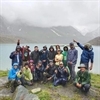

Small Group Size
Our batch sizes are capped at 15 for smaller treks with the trek leader and trekker ratio of 1:8. This ratio, in our years of experience, has proven to deliver the best trekking experience for individuals as well as groups. Capping the size of the group ensures individual attention to each trekker so that no signs of distress or need during the trek go unnoticed. It also helps to form a more cohesive cohort with better group energy which helps define the rhythm and pace of days on the trek. As you go higher up on the BRS scale, since the stakes are higher, expeditions have an even smaller group size with the ratio of expedition leader to climber set at 1:2.
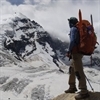

Qualified Trek Leaders
We follow a rigorous regime of hiring and training our experts in the field. Each trek leader is a certified mountaineer with years of experience in the field. In addition to their qualification, they also go through practical and situational training to tackle any and all kinds of sudden conditions that may present themselves on the ground. Being unpredictable is the core nature of the mountains but being ready for any circumstance as best as possible is a controllable asset that we try to nurture. Our field experts are also trained in basic medicine and first-aid response. Watch: Forerunners - The Making of A Trek Leader At Bikat Adventures
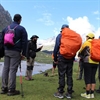

Guided Progression
Since Bikat Adventures is a learning-based organization, we help you climb up the ladder of difficulty within the sphere of outdoor adventure systematically. Our on-ground training modules are designed to handhold you through the upskilling process so that you are ready to take on bigger challenges.
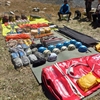

Equipment Quality and Check
All the gear used on our treks and expeditions is tried and tested, maintained for good quality, and is overall top-notch in quality and condition. We are continually looking to obtain the best of everything there is in the market so as to ensure optimum safety.
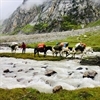

Support Systems
Along with the staff you see on-ground, we have a team of superheroes working in the background to give you the best experience possible. Our background team also comprises local staff from each area who know the region best. Having local support helps with studying the area, pre-planning, execution, and in receiving timely support in case of emergencies in these remote locations.
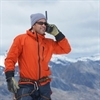

Communication
Our on-field staff is in constant contact with our teams based in primary locations so as to eliminate any avoidable delay in reaching additional help and support when required. We try to use the best tools for communication available, including satellite phones, in regions where they are not restricted.
What our customers Say
Cancellation Policy
Cash refund
Cancellations up to 60 days prior to departure date
Between 60 days upto 30 days prior to departure date
Between 30 days upto 10 days prior to departure date
Less than 10 days prior to departure date
Voucher refund
Cancellations up to 30 days prior to departure date
Between 30 days upto 15 days prior to departure date
Between 15 days upto 10 days prior to departure date
Less 10 days prior to departure date
- Cash refund is applicable only in case of bookings made without using any promotional offer code or Cancellation Vouchers or Discounts
- This is only a brief of cancellation terms. For finer details please refer Detailed Cancellation Policy.
Blog Posts
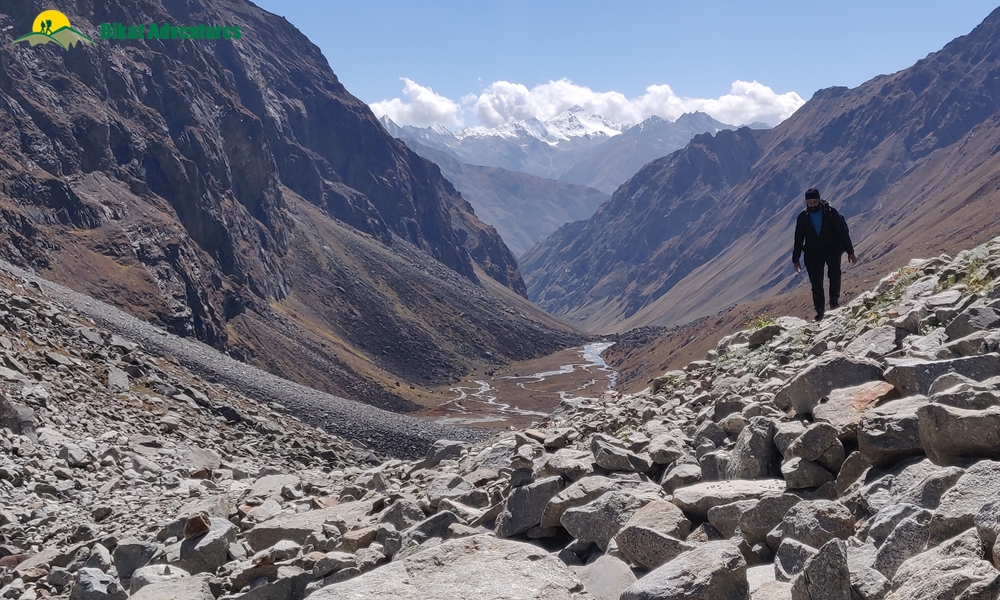

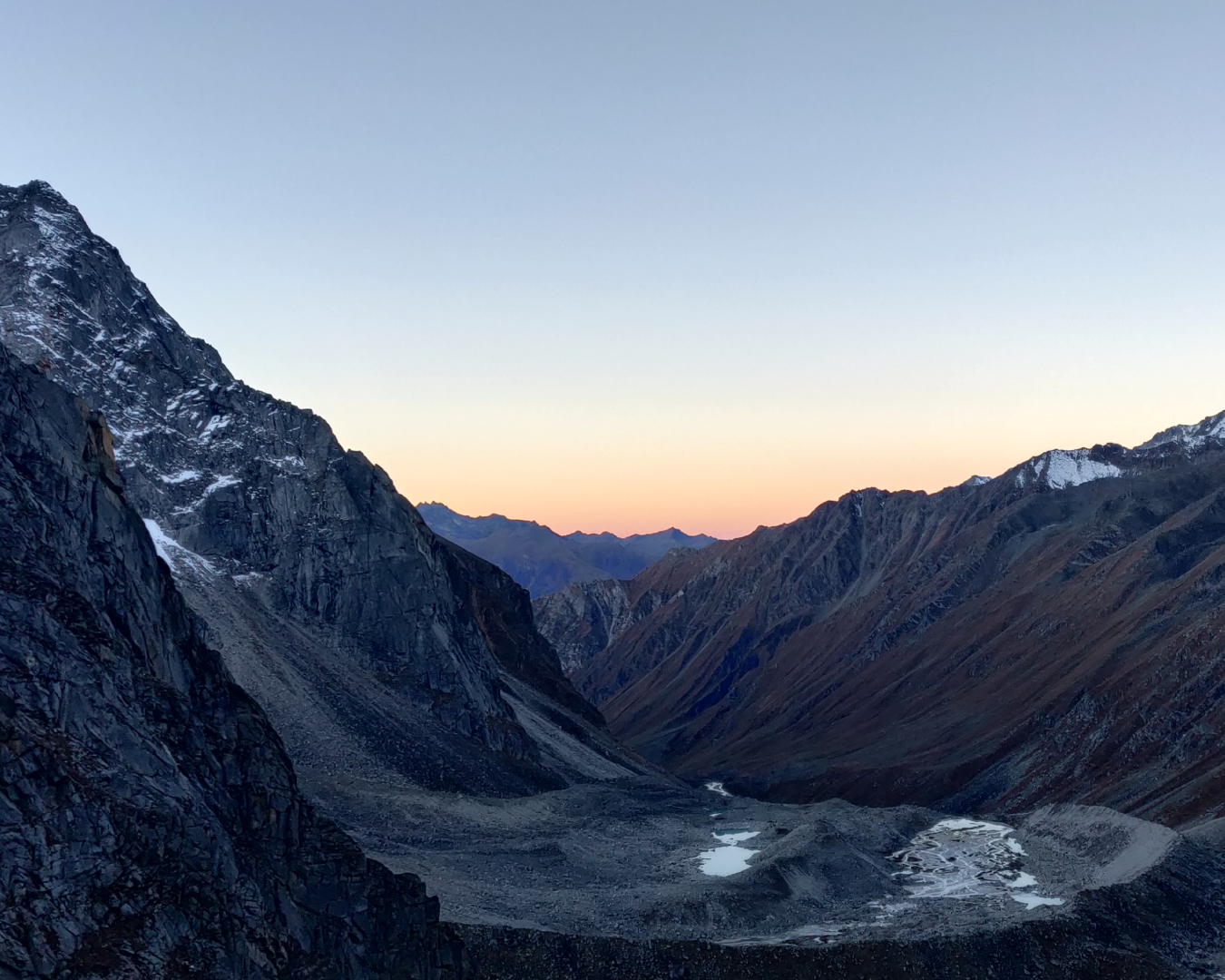
Similar Adventures
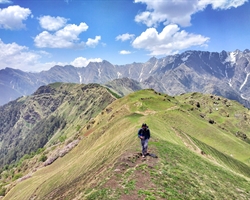
Baraadsar Lake Trek
A Challenging Off-beat Trail tucked between the Rupin and Supin Valleys
Uttarakhand
8 Days
BRS 5
4600 m
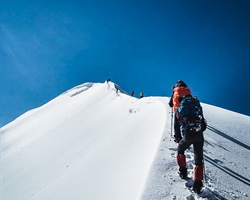
Bali Pass Trek
A badass trek for seasoned trekkers
Uttarakhand
9 Days
BRS 5
4950 m
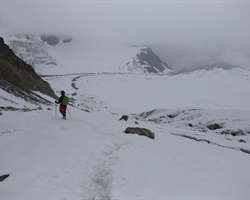
Lamkhaga Pass Trek
An Ultimate Off-beat Challenge of Uttarakhand
Uttarakhand
10 Days
BRS 6
5280 m
